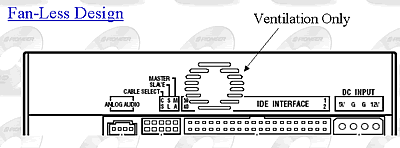Pioneer DVR-S706-J
16. Conclusion
Review Pages
2. Data CD Reading Tests
3. CD Error Correction Tests
4. DVD reading tests
5. DVD Error Correction Tests
6. DAE Tests
7. Protected AudioCD Tests
8. Game Protection Tests
9. CD Recording Tests
10. Writing Quality Tests - 3T Jitter Tests
11. Writing Quality Tests - C1 / C2 / CU Error Measurements
12. DVD Recording Tests
13. PI/PO quality results for DVD+R/RW
14. PI/PO quality results for DVD-R/RW
15. BitSetting Tests
16. Conclusion
17. Noise Reduction
PIONEER DVR-S706 DVD±R/RW recorder - Page 16
QuietDrive Utility
“Honeycomb chassis” reduces the drives’ resonance.
When a disc’s rotation gets faster, the “sweeping-wind” noise levels become much more audible.To dampen this noise level, the DVR-A07XL has employed a Honeycomb chassis design in order to lessen the noise vibration made by the upper shell hard. Additional noise-absorbing pads are placed on the internal side of the shell.

“Quiet Firmware” further reduces the drives noise.
When the disc’s rotation gets faster, noise levels become much more audible. To dampen this noise level, the DVR-A07XL has adopted a switch-able firmware version which is used in conjunction with the “Quiet Drive Utility”.
There are 3 modes available in the “Quiet Drive Utility”
-
Quiet Mode
- Performance Mode
- Standard Mode

Fanless Desing
With continued development and refinement, DVD writers can achieve recordings
at ultra-high speed without the need for an additional cooling fan to reduce
any internally generated heat.

According to Pioneer the combination of those three features reduse the noise levels up to 75% ( compared to DVR-107D).

Review Pages
2. Data CD Reading Tests
3. CD Error Correction Tests
4. DVD reading tests
5. DVD Error Correction Tests
6. DAE Tests
7. Protected AudioCD Tests
8. Game Protection Tests
9. CD Recording Tests
10. Writing Quality Tests - 3T Jitter Tests
11. Writing Quality Tests - C1 / C2 / CU Error Measurements
12. DVD Recording Tests
13. PI/PO quality results for DVD+R/RW
14. PI/PO quality results for DVD-R/RW
15. BitSetting Tests
16. Conclusion
17. Noise Reduction













